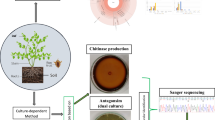Abstract
The deciduous linden tree (Tilia amurensis Rupr.) is protected at National Level II in China as a species of ecological and economic importance. The objective of this study was to assess and compare the ectomycorrhizal communities associated with T. amurensis in natural versus urban forests of central Heilongjiang Province. The percentage of T. amurensis colonisation by ectomycorrhiza was more than 60 % in urban forests, compared to 34–49 % in natural forests. Use of a combination of morphological and molecular methods documented 18 ECM (ectomycorrhizal) types among three sites; 12–13 ECM species were identified in the natural sites versus 9 species in the urban site. Four ECM species (Boletus sp., Tuber sp., Inocybe sp.2, Leccinum sp.1) were the dominant mycorrhizal symbionts, and Cenococcum geophilum and Russula sp. were found only in the natural forests.


Similar content being viewed by others
References
Agerer R (1987–2008) Colour Atlas of Ectomycorrhizae, 1st–14th delivery. EinhornVerlag Eduard Dietenberger, Germany, p 1–113
Belfiori B, Riccioni C, Tempesta S, Pasqualetti M, Paolocci F, Rubini A (2012) Comparison of ectomycorrhizal communities in natural and cultivated Tuber melanosporum truffle grounds. FEMS Microbiol Ecol 81(3):547–561
Beniwal RS, Langenfeld-Heyser R, Polle A (2010) Ectomycorrhiza and hydrogel protect hybrid poplar from water deficit and unravel plastic responses of xylem anatomy. Environ Exp Bot 69(2):189–197
Benucci GMN, Raggi L, Albertini E, Grebenc T, Bencivenga M, Falcinelli M, Di Massimo G (2011) Ectomycorrhizal communities in a productive Tuber aestivum Vittad. orchard: composition, host influence and species replacement. FEMS Microbiol Ecol 76(1):170–184
Buscot F, Munch JC, Charcosset JY, Gardes M, Nehls U, Hampp R (2000) Recent advances in exploring physiology biodiversity of ectomycorrhizas highlight the functioning of these symbioses in ecosystems. FEMS Microbiol Rev 24:601–614
Garbaye J, Churin JL (1996) Effect of ectomycorrhizal inoculation at planting on growth and foliage quality of Tilia tomentosa. J Arboric 22(1):29–34
Gardes M, Bruns TD (1996) Community structure of ectomycorrhizal fungi in a Pinus muricata forest: above- and below-ground views. Can J Bot 74(10):1572–1583
Giomaro G, Sisti D, Zambonelli A, Amicucci A, Cecchini M, Comandini O, Stocchi V (2002) Comparative study and molecular characterization of ectomycorrhizas in Tilia americana and Quercus pubescens with Tuber brumale. FEMS Microbiol Lett 216(1):9–14
Grogan P, Baar J, Bruns TD (2000) Below-ground ectomycorrhizal community structure in a recently burned bishop pine forest. J Ecol 88(6):1051–1062
Iotti M, Lancellotti E, Hall I, Zambonelli A (2010) The ectomycorrhizal community in natural Tuber borchiigrounds. FEMS Microbiol Ecol 72(2):250–260
Khasa PD, Sigler L, Chakravarty P, Dancik BP, Erickson L, McCurdy D (2001) Effect of fertilization on growth and ectomycorrhizal development of container-grown and bare-root nursery conifer seedlings. New Forest 22(3):179–197
Liang Y, Guo LD, Du XJ, Ma KP (2007) Spatial structure and diversity of woody plants and ectomycorrhizal fungus sporocarps in a natural subtropical forest. Mycorrhiza 17(4):271–278
Lilleskov EA, Bruns TD, Horton TR, Taylor DL, Grogan P (2004) Detection of forest stand-level spatial structure in ectomycorrhizal fungal communities. FEMS Microbiol Ecol 49(2):319–332
Ma DL, Yang GT, Mu LQ (2010) Morphological and molecular analyses of ectomycorrhizal diversity in Pinus densiflora seedlings. Symbiosis 51(8):233–238
McCune B, Mefford MJ. 1999. Pc-ord Multivariate analysis of ecological data, Version 6.0, MjM Software Gleneden Beach.(http://cc.oulu.fi/~jarioksa/opetus/metodi/vegantutor.pdf)
Nielsen J, Rasmussen H (1999) Mycorrhizal status and morphotype diversity in Tilia cordata a pilot study of nurseries and urban habitats. Acta Horti 496:451–459
Pigott CD (1982) Fine structure of mycorrhiza formed by Cenococcum geophilum Fr. on Tilia cordata Mill. New Phytol 92(4):501–512
Pigott CD (1991) Tilia cordata Miller. J Ecol 79(4):1147–1207
Põlme S, Bahram M, Yamanaka T, Nara K, Dai YC, Grebenc T, Kraigher H, Toivonen M, Wang PH, Matsuda Y, Naadel T, Kennedy PG, Tedersoo L (2013) Biogeography of ectomycorrhizal fungi associated with alders (Alnus spp.) in relation to biotic and abiotic variables at the global scale. New Phytol 198(4):1239–1249
Sisti D, Zambonelli A, Giomaro G, Rossi I, Ceccaroli P, Citterio B, Benedetti PA, Stocchi V (1998) In vitro mycorrhizal synthesis of micropropagated Tilia platyphyllos Scop. plantlets with Tuber borchii Vittad. mycelium in pure culture. Acta Horti 457:379–384
Smith SE, Read DJ (2008) Mycorrhizal symbiosis(2 Edition). Academic Press, Harcourt Brace & Company, San Diego, pp 1–625
Smith ME, Douhan GW, Rizzo DM (2007) Ectomycorrhizal community structure in a xeric Quercus woodland based on rDNA sequence analysis of sporocarps and pooled roots. New Phytol 174(4):847–863
Tedersoo L, Hansen K, Perry BA, Kjoller R (2006) Molecular and morphological diversity of pezizalean ectomycorrhiza. New Phytol 170(3):581–596
Timonen S, Kauppinen P (2008) Mycorrhizal colonization patterns of Tilia trees in street, nursery and forest habitats in southern Finland. Urban For Urban Green 7(4):265–276
Wang Q, Guo LD (2010) Ectomycorrhizal community composition of Pinus tabulaeformis assessed by ITS-RFLP and ITS sequences. Botany 88(6):590–595
Wang Q, Gao C, Guo LD (2011) Ectomycorrhizae associated with Castanopsis fargesii(Fagaceae) in a subtropical forest China. Mycol Progress 10(3):323–332
Xu ML, Zhu JJ, Kang HZ, Xu AH, Zhang JX, Li FQ (2008) Optimum conditions for pure culture of major ectomycorrhizal fungi obtained from Pinus sylvestris var. mongolica plantations in southeastern Keerqin sandy lands, China. J For Res 19(2):113–118
Author information
Authors and Affiliations
Corresponding author
Additional information
Project funding: This work was financially supported by Wild Plants Protection Management Program of State Forestry Administration and Start Research Grants of Postdoctoral Researcher in Heilongjiang.
The online version is available at http://www.springerlink.com
Corresponding editor: Zhu Hong
Rights and permissions
About this article
Cite this article
Cui, L., Mu, Lq. Ectomycorrhizal communities associated with Tilia amurensis trees in natural versus urban forests of Heilongjiang in northeast China. J. For. Res. 27, 401–406 (2016). https://doi.org/10.1007/s11676-015-0158-1
Received:
Accepted:
Published:
Issue Date:
DOI: https://doi.org/10.1007/s11676-015-0158-1




